dYdX-Strategie-Entwurfsbeispiel
Schriftsteller:- Ich bin ein Idiot., Erstellt: 2022-04-08 16:47:32, aktualisiert: 2022-04-08 17:47:39dYdX-Strategie-Entwurfsbeispiel
Als Reaktion auf die Bedürfnisse vieler Benutzer hat die FMZ-Plattform kürzlich die dezentrale Plattform dYdX unterstützt. Freunde mit Strategien können glücklich auf dYdX graben. Vor langer Zeit wollte ich eine zufällige Handelsstrategie schreiben. Es spielt keine Rolle, ob ich Profit mache oder nicht. Der Zweck ist es, meine Technik zu üben und das Strategie-Design übrigens zu lehren. Als nächstes entwerfen wir gemeinsam eine zufällige Plattform-Strategie. Mach dir keine Sorgen um die Leistung der Strategie und lerne einfach das Strategie-Design.
Erst die Bergbauarbeiten teilen
Der Mining-Screenshot der Strategie im Artikel.
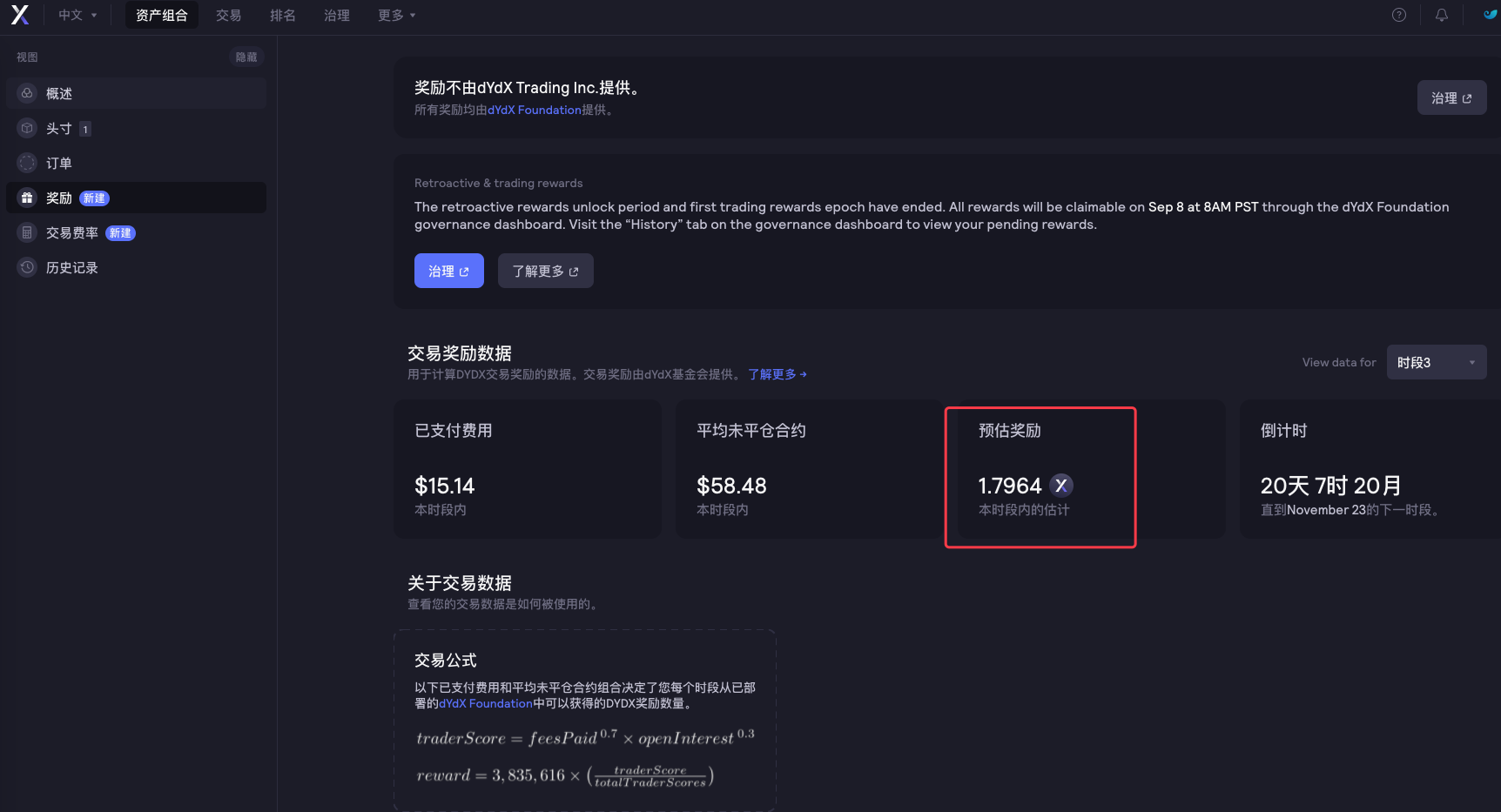
Willkommen Freunde, die gute Bergbaustrategie-Ideen zu teilen haben!
Random Trading Strategy Design (Zufallsstrategieentwurf)
Lassen Sie uns einen Brainstorming haben! Wir planen, eine Strategie zu entwerfen, um Befehle zufällig zu platzieren, ohne Indikatoren oder Preise zu betrachten. Bestellen ist nichts anderes als Long und Short zu machen, was auf Wahrscheinlichkeit setzt. Dann verwenden wir zufällige Zahlen von 1 bis 100, um zu bestimmen, ob Long oder Short geht.
Bedingung für das Ausführen von Long: Zufallszahlen von 1 bis 50. Bedingung für die Kurzzeit: Zufallszahlen von 51 bis 100.
Beide benötigen 50 Zahlen. Als nächstes sollten wir darüber nachdenken, wie man Positionen schließt. Da es sich um eine Wette handelt, muss es einen Gewinn- oder Verluststandard geben. Dann setzen wir einen festen StopProfit und einen festen StopLoss als Gewinn- oder Verluststandard. Nehmen wir StopProfit als Gewinn und StopLoss als Verlust. Was die Angemessenheit von StopProfit und StopLoss betrifft, beeinflusst es tatsächlich das Gewinn-Verlust-Verhältnis und auch die Gewinnrate! (Ist es effektiv, eine Strategie auf diese Weise zu entwerfen? Kann es garantiert werden, dass es eine positive mathematische Erwartung ist? Jedenfalls machen wir es zuerst! Weil es für Lernen und Forschung ist!)
Der Handel ist nicht kostenlos, und es gibt Faktoren wie Slippoint und Gebühren, die genug sind, um unsere zufällige Handelsgewinnrate auf die Seite von weniger als 50% zu ziehen. Da es sich um eine Wette handelt, sollte die Wahrscheinlichkeit, dass ich 10 oder 8 Mal hintereinander verliere, nicht sehr groß sein. Also möchte ich einen kleinen Auftragsbetrag im ersten Trade platzieren, so klein es sein kann. Wenn ich dann die Wette verliere, erhöhe ich den Auftragsbetrag und lege weiterhin zufällige Aufträge auf.
Die Strategie ist so einfach wie das.
Quellcode des Designs:
var openPrice = 0
var ratio = 1
var totalEq = null
var nowEq = null
function cancelAll() {
while (1) {
var orders = _C(exchange.GetOrders)
if (orders.length == 0) {
break
}
for (var i = 0 ; i < orders.length ; i++) {
exchange.CancelOrder(orders[i].Id, orders[i])
Sleep(500)
}
Sleep(500)
}
}
function main() {
if (isReset) {
_G(null)
LogReset(1)
LogProfitReset()
LogVacuum()
Log("reset all data", "#FF0000")
}
exchange.SetContractType(ct)
var initPos = _C(exchange.GetPosition)
if (initPos.length != 0) {
throw "Position detected when starting the strategy!"
}
exchange.SetPrecision(pricePrecision, amountPrecision)
Log("setPrecision", pricePrecision, amountPrecision)
if (!IsVirtual()) {
var recoverTotalEq = _G("totalEq")
if (!recoverTotalEq) {
var currTotalEq = _C(exchange.GetAccount).Balance // equity
if (currTotalEq) {
totalEq = currTotalEq
_G("totalEq", currTotalEq)
} else {
throw "fail to obtain the initial equity"
}
} else {
totalEq = recoverTotalEq
}
} else {
totalEq = _C(exchange.GetAccount).Balance
}
while (1) {
if (openPrice == 0) {
// update account information, and calculate the profit
var nowAcc = _C(exchange.GetAccount)
nowEq = IsVirtual() ? nowAcc.Balance : nowAcc.Balance // equity
LogProfit(nowEq - totalEq, nowAcc)
var direction = Math.floor((Math.random()*100)+1) // 1~50 , 51~100
var depth = _C(exchange.GetDepth)
if (depth.Asks.length <= 2 || depth.Bids.length <= 2) {
Sleep(1000)
continue
}
if (direction > 50) {
// long
openPrice = depth.Bids[1].Price
exchange.SetDirection("buy")
exchange.Buy(Math.abs(openPrice) + slidePrice, amount * ratio)
} else {
// short
openPrice = -depth.Asks[1].Price
exchange.SetDirection("sell")
exchange.Sell(Math.abs(openPrice) - slidePrice, amount * ratio)
}
Log("place", direction > 50 ? "buy order" : "sell order", ",price:", Math.abs(openPrice))
continue
}
var orders = _C(exchange.GetOrders)
if (orders.length == 0) {
var pos = _C(exchange.GetPosition)
if (pos.length == 0) {
openPrice = 0
continue
}
// detect close positions
while (1) {
var depth = _C(exchange.GetDepth)
if (depth.Asks.length <= 2 || depth.Bids.length <= 2) {
Sleep(1000)
continue
}
var stopLossPrice = openPrice > 0 ? Math.abs(openPrice) - stopLoss : Math.abs(openPrice) + stopLoss
var stopProfitPrice = openPrice > 0 ? Math.abs(openPrice) + stopProfit : Math.abs(openPrice) - stopProfit
var winOrLoss = 0 // 1 win , -1 loss
// plot
$.PlotLine("bid", depth.Bids[0].Price)
$.PlotLine("ask", depth.Asks[0].Price)
// stop loss
if (openPrice > 0 && depth.Bids[0].Price < stopLossPrice) {
exchange.SetDirection("closebuy")
exchange.Sell(depth.Bids[0].Price - slidePrice, pos[0].Amount)
winOrLoss = -1
} else if (openPrice < 0 && depth.Asks[0].Price > stopLossPrice) {
exchange.SetDirection("closesell")
exchange.Buy(depth.Asks[0].Price + slidePrice, pos[0].Amount)
winOrLoss = -1
}
// stop profit
if (openPrice > 0 && depth.Bids[0].Price > stopProfitPrice) {
exchange.SetDirection("closebuy")
exchange.Sell(depth.Bids[0].Price - slidePrice, pos[0].Amount)
winOrLoss = 1
} else if (openPrice < 0 && depth.Asks[0].Price < stopProfitPrice) {
exchange.SetDirection("closesell")
exchange.Buy(depth.Asks[0].Price + slidePrice, pos[0].Amount)
winOrLoss = 1
}
// detect pending orders
Sleep(2000)
var orders = _C(exchange.GetOrders)
if (orders.length == 0) {
pos = _C(exchange.GetPosition)
if (pos.length == 0) {
if (winOrLoss == -1) {
ratio++
} else if (winOrLoss == 1) {
ratio = 1
}
break
}
} else {
// cancel pending orders
cancelAll()
Sleep(2000)
pos = _C(exchange.GetPosition)
// after canceling, update positions, which needs to be detected again
if (pos.length == 0) {
if (winOrLoss == -1) {
ratio++
} else if (winOrLoss == 1) {
ratio = 1
}
break
}
}
var tbl = {
"type" : "table",
"title" : "info",
"cols" : ["totalEq", "nowEq", "openPrice", "bid1Price", "ask1Price", "ratio", "pos.length"],
"rows" : [],
}
tbl.rows.push([totalEq, nowEq, Math.abs(openPrice), depth.Bids[0].Price, depth.Asks[0].Price, ratio, pos.length])
tbl.rows.push(["pos", "type", "amount", "price", "--", "--", "--"])
for (var j = 0 ; j < pos.length ; j++) {
tbl.rows.push([j, pos[j].Type, pos[j].Amount, pos[j].Price, "--", "--", "--"])
}
LogStatus(_D(), "\n", "`" + JSON.stringify(tbl) + "`")
}
} else {
// cancel pending orders
// reset openPrice
cancelAll()
openPrice = 0
}
Sleep(1000)
}
}
Strategieparameter:

Die Strategie braucht einen Namen, und nennen wir sie "Raten Sie, welcher größer ist (dYdX Version).
Zurückprüfung
Der Backtest ist nur zur Referenz! Es ist hauptsächlich, um zu überprüfen, ob es irgendwelche Fehler in der Strategie gibt; Backtest mit Binance Futures.
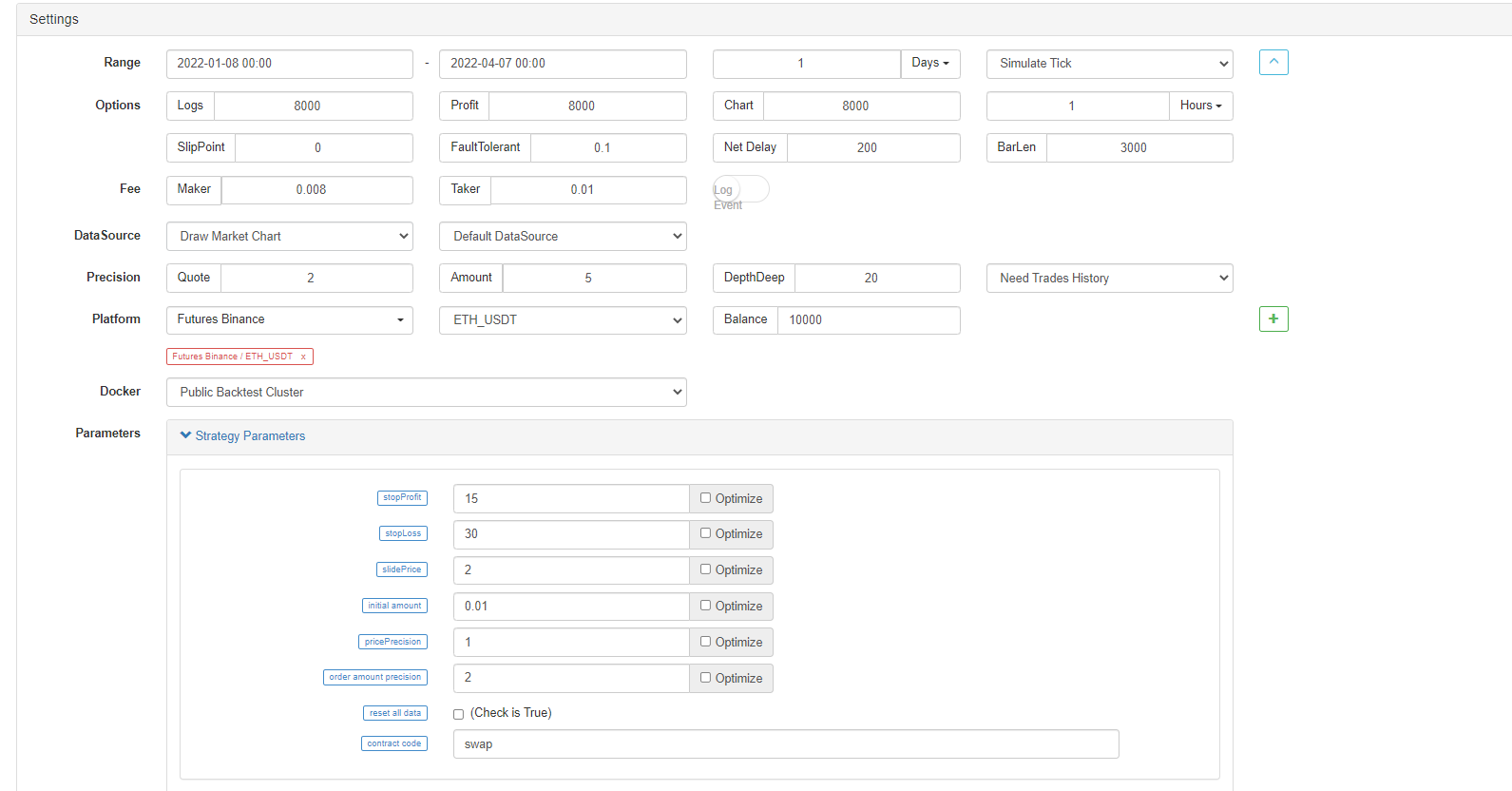

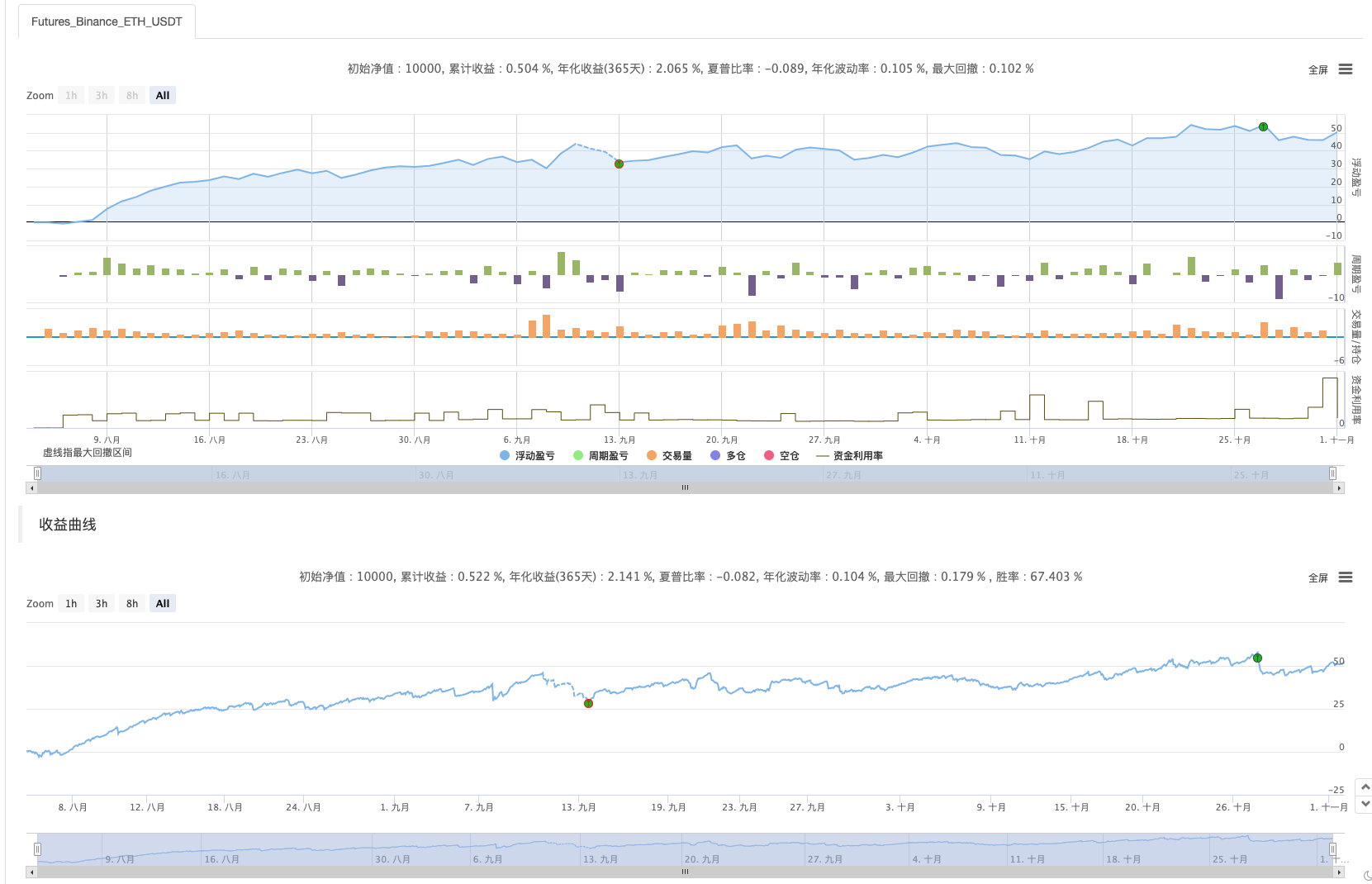
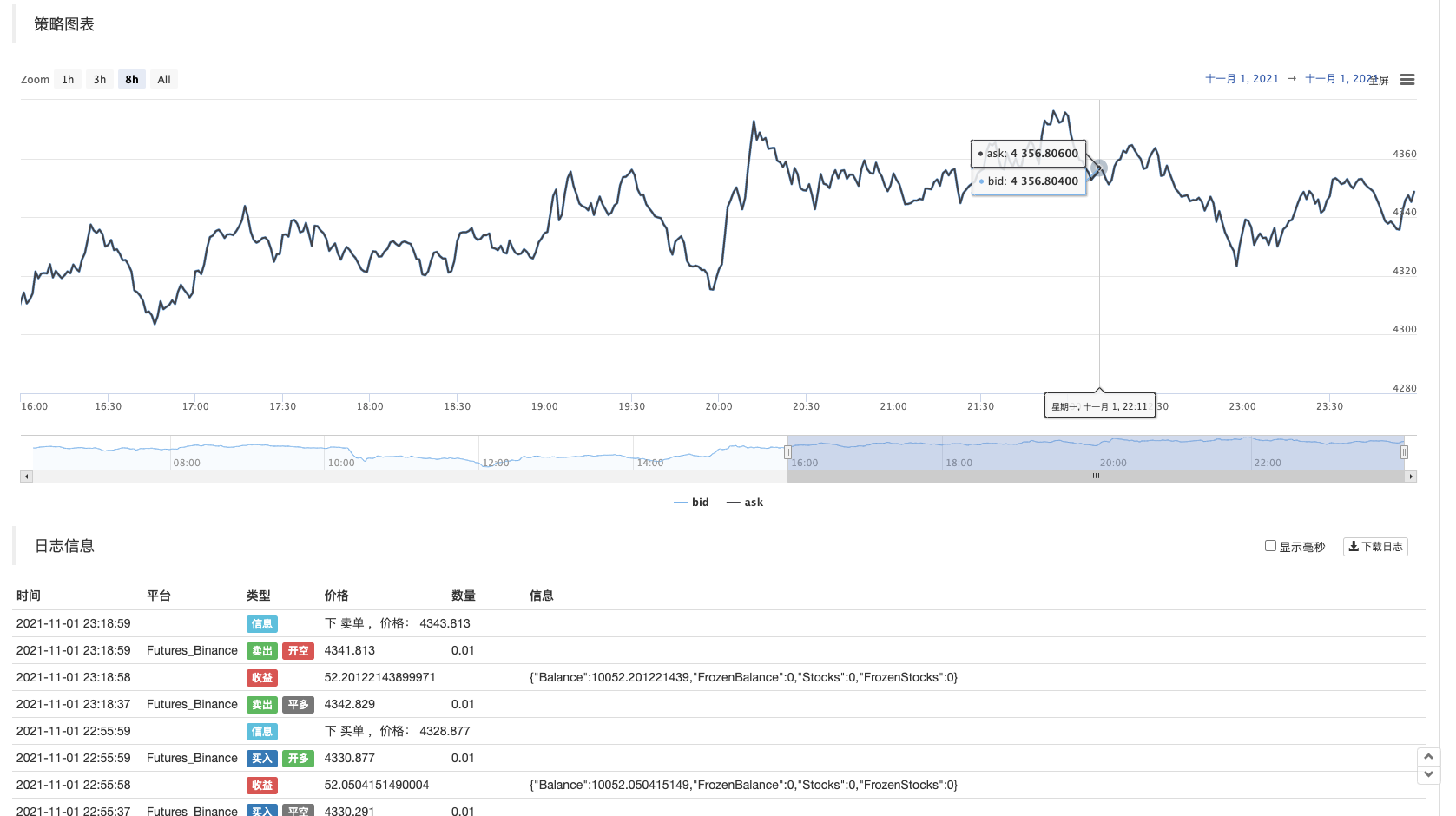
Der Backtest ist vorbei, keine Fehler, aber ich habe das Gefühl, dass das Backtest-System übereinstimmt.
In einem Bot laufen
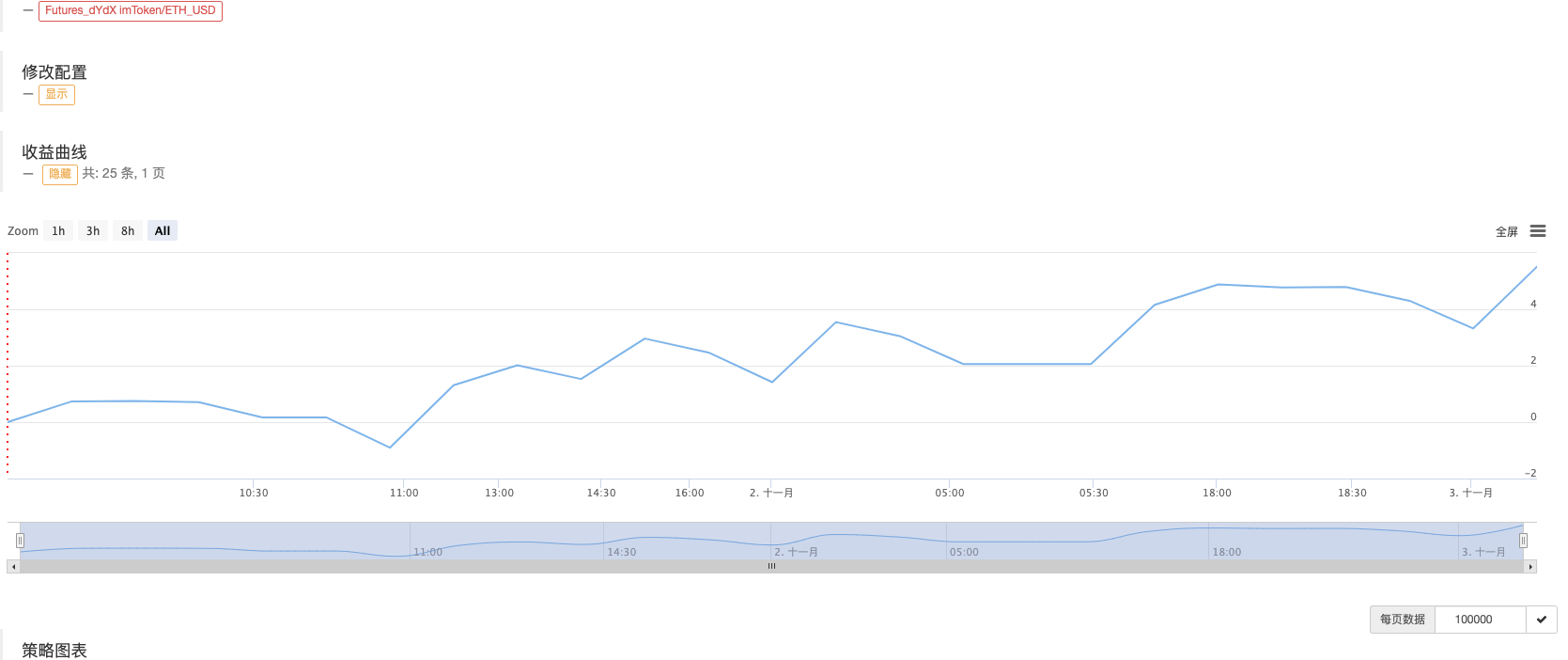
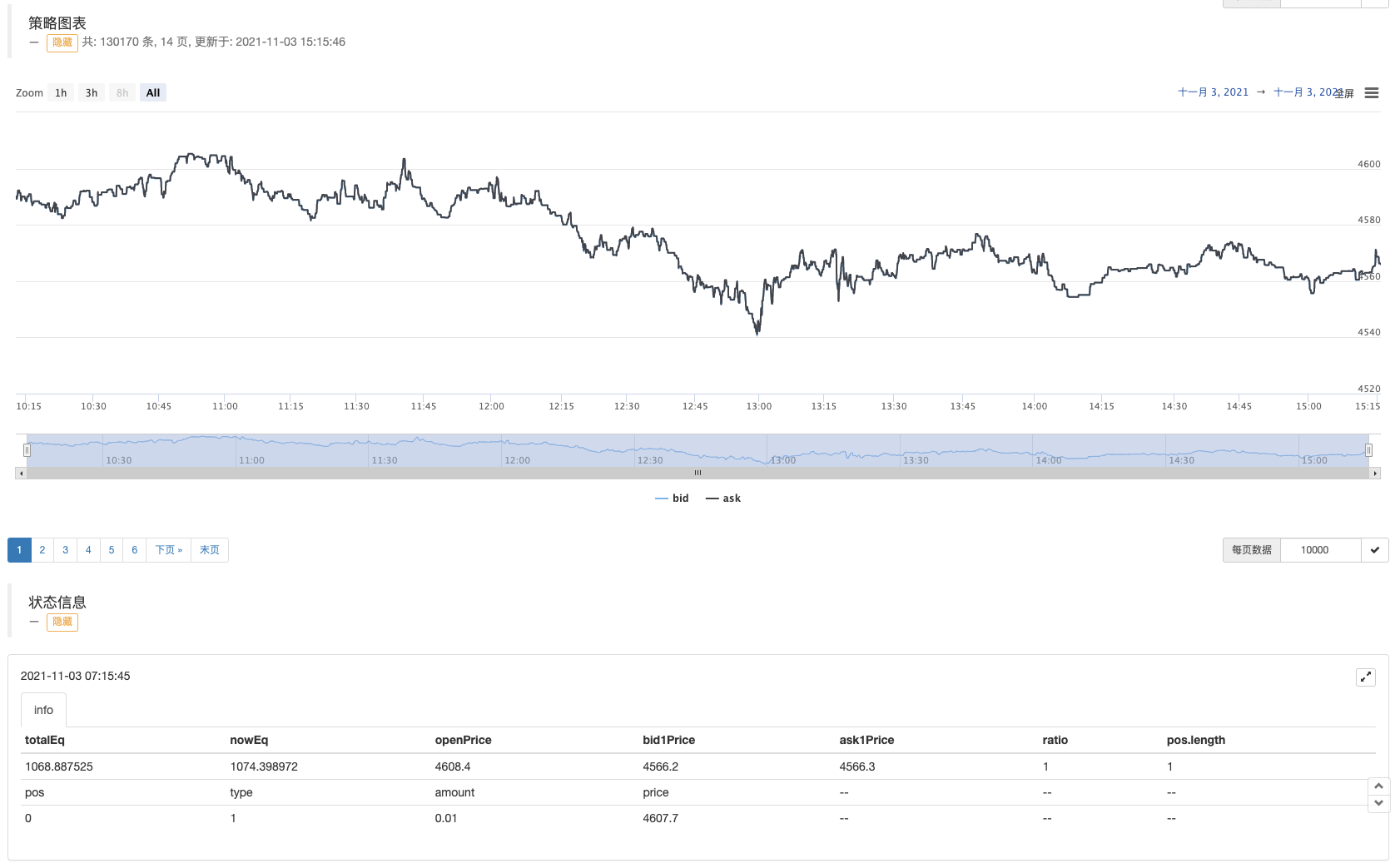
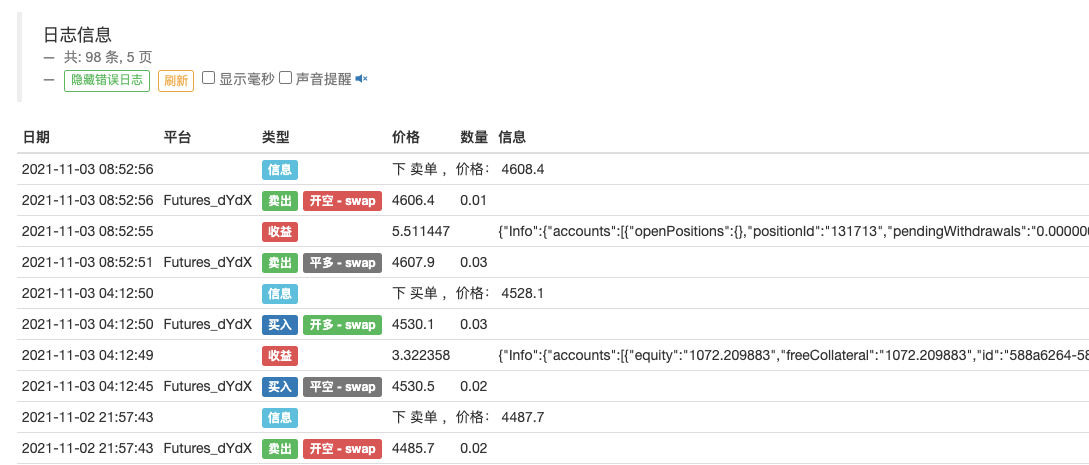
Diese Strategie dient nur zum Lernen und zur Referenz.Nicht tun.!! Nicht tun.Verwenden Sie es in einem echten Bot!
- Futures & Spot Spread Return Arbitrage Analyse in Krypto-Margin-Kontrakten
- Verzichten Sie auf das Drucken eines Logs
- Löschen Sie alle noch ausstehenden Bestellungen in aktuellen Währungen
- Schnelle Einführung der FMZ Quant Trading Platform APP
- Realisieren Sie einen einfachen Auftragsüberwachungsbot von Cryptocurrency Spot
- Eine Plattform, die auf FMZ basiert.
- Kryptowährungs-Kontrakt einfacher Auftragsüberwachungsbot
- Wenn Sie mit getdepth die entsprechende Zeitschrift erhalten möchten
- Ignoriert, gelöst
- Die Frage nach dem Gesichtswert
- Erste Erforschung der Anwendung von Python Crawler auf FMZ
Crawling Binance Ankündigungsinhalt - Hedge-Strategie-Design-Forschung & Beispiel für offene Spot- und Futures-Orders
- Aktuelle Situation und empfohlene Anwendung der Finanzierungsrate-Strategie
- Strategie für einen doppelten gleitenden Durchschnitts-Brechpunkt von Kryptowährungs-Futures (Teaching)
- Strategie für einen doppelten gleitenden Durchschnitt mit mehreren Symbolen (Teaching)
- Realisierung von Fisher Indicator in JavaScript und Plotting auf FMZ
- Treuhänder
- 2021 Kryptowährungs-TAQ-Überprüfung & Einfachste verpasste Strategie der 10-fachen Erhöhung
- Kryptowährungs-Futures Multi-Symbol ART-Strategie (Lehre)
- Aktualisieren! Kryptowährungs Futures Martingale Strategie